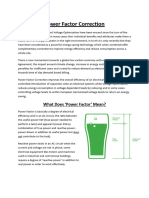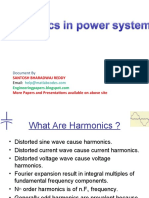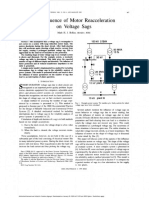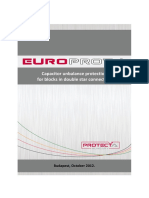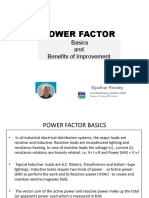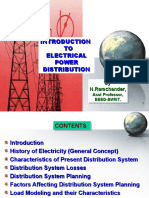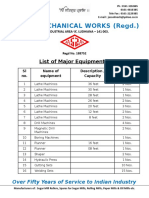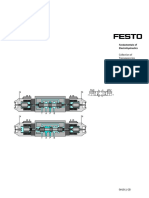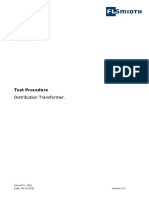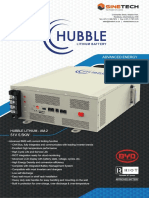Overview of Power Factor Correction
Presented to Central Vermont Public Service and Efficiency Vermont On November 5, 2007
�Topics
Basic Formulas (Ohms Law) Power Factor Fundamentals Improving Power Factor Utility Bill Analysis Sizing a Capacitor Capacitor Location Power Factor Correction Products
�Basic Formulas (Ohms Law)
�Power Factor Fundamentals
Terms to get you started
Active Power Measured in watts (normally shown as kW). Provides the working part of the power system. Producing heat, movement Reactive Power Measured in volt-ampere-reactive (normally shown as kVAr). Sustains the electromagnetic field. Provides no working part of the power system. Apparent Power Measured in Volt-Ampere (normally shown as kVA). Provided both working and nonworking parts of the power system.
�Power Factor Fundamentals
�Power Factor Fundamentals
�Power Factor Fundamentals
50 40
�Power Factor Fundamentals
�Power Factor Fundamentals
50
�Power Factor Fundamentals
50 28
�Power Factor Fundamentals
�Power Factor Fundamentals
Power Factor Triangle
Power Factor (PF) = Active Power Apparent Power PF close to 1.0 means electrical power is being used effectively Active Power (kW)
Reactive Power (kVAR) Apparent Power (kVA)
Capacitors provide reactive current and as a result reduce kVA and improve power factor
�Power Factor Fundamentals
�Power Factor Fundamentals
Power Factor is a measure of how effectively power is used
Inductive loads require two kinds of power to operate: Active Power (kW) Actually performs the work Reactive Power (kVAR) Maintains the electro-magnetic field
Apparent Power (kVA) Total power (vector sum of active and reactive power)
�Power Factor Fundamentals
Without Capacitor
Reactive Power Active Power Available Active Power
Utility
Motor
Motor
With Capacitor
Capacitor acts as a reactive generator
Utility
Motor
Motor
Capacitor
�Power Factor Fundamentals
Poor PF 0.70
Excellent PF > 0.95
�Power Factor Fundamentals
Power Factor of Typical Electrical Devices
Device Incandescent Lights Baseboard Heat Fan Motor Saw Mill Motor Power Factor 0.99+ 0.99+ 0.90 0.50
Low power factor typically results when motors are operated at significantly less than full load. Other examples of motors with low power factor: Conveyors Compressors Grinders Punch Presses
�Improving Power Factor
Power Factor (PF) = Active Power Apparent Power PF close to 1.0 means electrical power is being used effectively
Active power = 100 kW
�Improving Power Factor
Without Capacitor
100 kVAR
Reactive Power Active Power Available Active Power
142 kVA
100 kW
PF = .70
Utility
33 kVAR
Motor
Motor
With Capacitor
PF = .95
105 kVA
100 kW 67 kVAR
Utility
Motor
Motor
Capacitor
�Improving Power Factor
Benefits of Applying Capacitors
Elimination of Penalty Dollars
Improves your system power factor, reduces total KVA or KVAHours, saving you money on your electric power bill
Additional Capacity in Electrical System
Releases system capacity by reducing KVA on transformers, saving you from making new capital investment to serve new electrical loads
Reduction of I2R Losses
Reduces system losses, saving energy costs and allowing your equipment to run cooler and more efficiently
Improves Voltage on System
Allows motors to run more efficiently and cooler, improves their life and operation
�Utility Bill Analysis
Types of Power and Typical Loads
Type of Power
KW Kilowatt (Active Current)
Common Names
Active Power Kilowatt/Watt Power Real Power Resistive Power
Typical Load/Component
Resistor Incandescent Lights Toasters
KVAR = Kilovolt Amperes Reactive (Reactive Current)
Reactors/Inductors Reactive Power Capacitors Imaginary Power KVAR/VAR Power Inductive/Capacitive Power
Most electrical loads usually need a combination of both active and reactive current. KVA Kilovolt Amperes (Active + Reactive) Apparent Power Complex Power Total Power KVA/VA Power All industrial loads: -Motors -Welders -Variable Speed Drives -Lighting Loads
�Utility Bill Analysis
Basic Types Of Utility Billing Protocols
Billing Protocol
KVA
Concept
Utility bills for every Amp of current, both active and reactive. Typically based on peak current. Utility bills for KW demand plus a surcharge for low power factor, for example: below 95%, below 85%, etc.
How Capacitors Reduce Cost
Capacitors reduce reactive current and therefore peak current. Capacitors increase power factor to minimum required, eliminating surcharge. Sometimes a credit for high power factor.
KW demand with power-factor adjustment
KW demand with reactive demand charge
Utility bills for KW demand plus a surcharge for excessive reactive demand.
Capacitors reduce reactive demand, eliminating surcharge.
�Utility Bill Analysis
Here are savings of a Detroit Edison customer after improving PF to >85. The power triangle started out at 812 KW, 1160 KVA and 828 KVAR. The customer installed capacitor banks totaling 410 KVAr. The final power triangle numbers were 812 KW, 913 KVA and 418 KVAR. What does that mean in dollars for the customer: The customer, doing the same amount of work but now with capacitors installed, has eliminated a $650.00 monthly penalty. This would translate in to an annual savings of $7,800.00. The capacitors and installation project totaled $7,351.00. ROI for the project was less than 12 months. How does this benefit the electrical system: The utility has to generate 247 less kVA (1160-913=247). The customer has also unloaded his transformer of 247 kVA, which will allow for additional loads in the future without having to increase the transformer size.
�Utility Bill Analysis
A utility bill shows an average power factor of 0.72 with an average KW of 627. How much KVAR is required to improve power factor to 0.95? Using a PFC Multiplier Table (next slide) 1. Locate 0.72 (original PF) in column 1. 2. Read across desired PF to 0.95 column, intersect at 0.635 multiplier 3. Multiply 627 (average KW) by 0.635 = 398 KVAR 4. Install 400 KVAR to improve PF to 95%
��Utility Bill Analysis
Try this one yourself-
A utility bill shows an average power factor of 0.79 with an average kW of 865. How much KVAR is required to improve power factor to 0.95?
The average kW can be calculated in a few different ways depending on the information available on the utility bill.
�Sizing a Capacitor
Determine: HP Motor Type (Frame, Design) RPMs Use the following table to determine KVAR
The following table shows suggested maximum capacitor ratings to raise full load PF to approximately 95%
�Sizing a Capacitor
�Capacitor Locations
Location A: New motor installation where overloads can be adjusted to reduced amp draw. Existing motors when unable to place connection between starter and overloads (overloads must be sized according to new amp draw). Location B: Normally used for most motor applications Location C: Used when motors are jogged, plugged, reversed; for multi-speed motors, or reduced-voltage start motors. Also motors that start frequently.
�Products
Power Factor Correction Capacitors
CALMOUNT brand capacitor series Correct poor power factor at the load
Fuses and fuse block NEMA 12 enclosure Resistor network Capacitor cell
Indication lights
�Products
Power Factor Correction Capacitors
Capacitor Characteristic
Cell Casing Cell Phases Pressure interrupter Cell Contents Replaceable Cells Power Termination Loss-of-kVAR Signal Fusing Conduit entry Enclosure design NEMA enclosure 3-phase cell Open, safe, non-flammable event Dry Individual capacitor cells easy to replace, if necessary. Key feature for MRO market. Threaded stud, secure Patented signal (CelTel) All capacitors are fused Bottom or back conduit entry. Easier to wire; requires less material Lift-off cover, open on 4 sides around wire termination Easier, faster to maintain NEMA 12-type standard
Myron Zucker Advantages/Benefits
Industrial grade metal cell case, 20-year life
�Products
Power Factor Correction Capacitors
Multical Corrects up to 4 motors with single capacitor assembly
Traymount -Open-style capacitor for Motor Control Center
�Products
Power Factor Correction Capacitors
Capacibank Autocapacibank Distribution center, service entrance
�Benefits & Features
Low Voltage: 240, 480, 600 Volt other ratings available U.L. Listed Patented CelTel for loss-of-capacitance signal and monitoring system for auto-disconnect feature Broadest PFCC product offering in the industry
�People Who Specify and/or Purchase PFCCs
End User (How is your power factor / power quality?)
Plant Engineers Maintenance Supervisors New Construction Primary Utility User
Refrigeration & Lighting Waste Water Treatment Facilities Plastics Extrusion Plants Automotive Plants Plating Plants
OEMs Controls Engineers Electrical Motor Suppliers Electrical Distributors A & E firms Utility Account Reps
�What Does Poor Factor Mean For.
The Supplier
Ineffective use of transmission lines Ineffective use of generators Loss of productivity since more resources (coal, water, etc.) is required to produce the same amount of real power used.
The User
Increase of thermal loss in the installed devices (I2R) Larger capacity supply line, transformer, power usage Increase cost of use for electricity
�Still need help?
Just call Paul!
(401) 473-8516 or paul_ecs@msn.com
If general information is provided: We will recommend unit rating and style If One-Line diagram is provided We will recommend location of capacitors If electrical bills are provided We will calculate monthly power cost savings and payback time of recommended products
�Questions?
�Harmonics?!
to be continued


